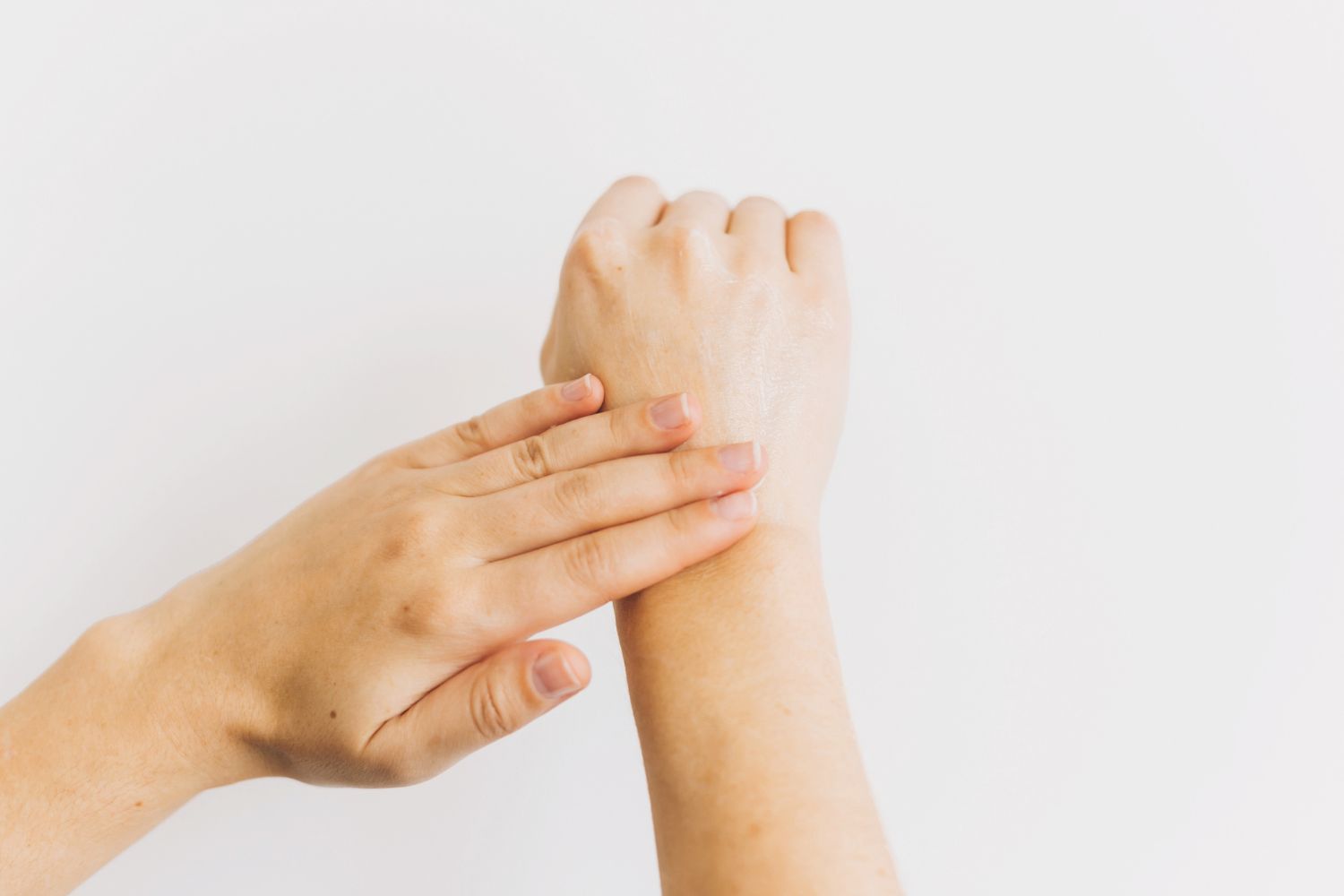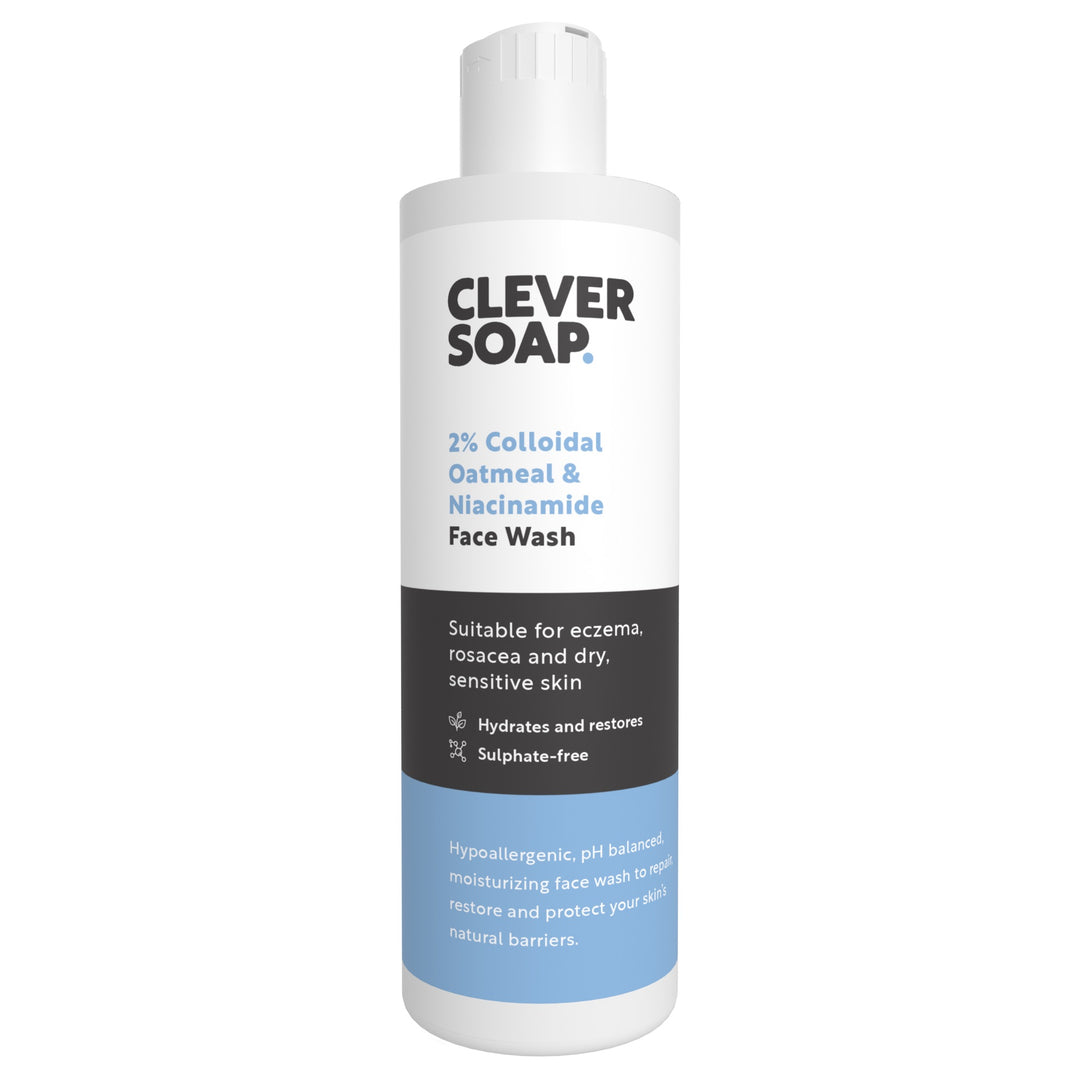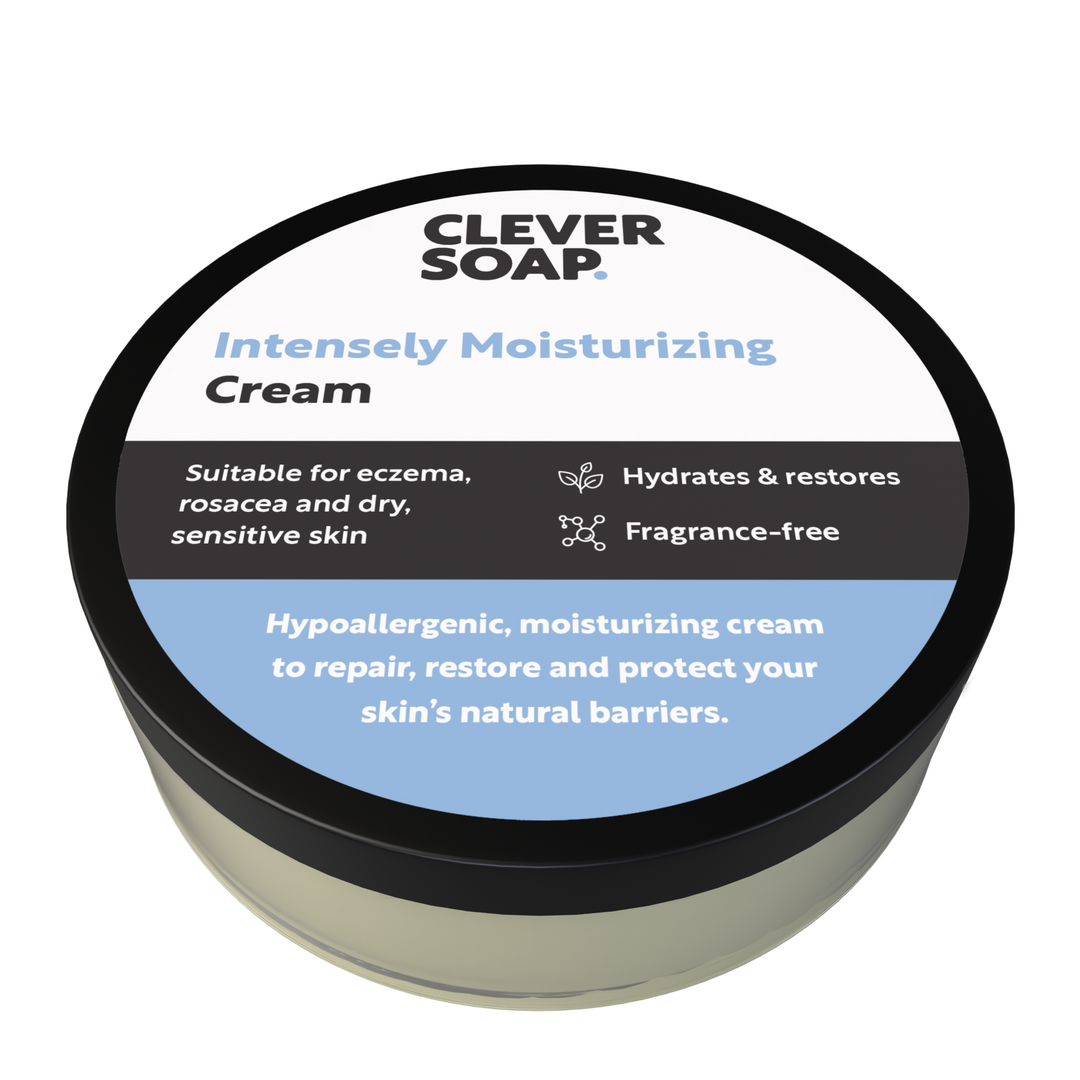U.K. DELIVERY £1.99, FREE FOR ORDERS OVER £25 | INTERNATIONAL DELIVERY FROM £9.99

Dry Skin
An Introduction To Dry Skin
Dry skin, medically known as xerosis, is a common dermatological condition that affects most people at some point in their life to some degree. It is characterized by rough or scaling skin and can significantly impact an individual's quality of life in more severe cases.
Dry skin can be influenced by a variety of factors, including environmental conditions, age, gender, and genetic makeup [1]. It can also be associated with certain health conditions, such as type 2 diabetes mellitus [2] and atopic dermatitis [3].
Sebum, secreted by the sebaceous glands within the skin, along with other epidermal lipids, helps maintain skin hydration by providing a protective lipid layer on the skin's surface, reducing fluid loss through the epidermis, the outermost layer of skin [4]. However, when the skin's hydration balance is disrupted, it can lead to dryness. This can be due to intrinsic factors like aging or external factors such as exposure to sunlight, extreme weather or skincare products. Certain genetic conditions can also lead to dry skin.

Treatment for dry skin often involves the application of moisturizers or lotions that contain ingredients that help the body to retain moisture and soothe the skin. In some cases, more targeted treatments may be required, such as the use of specific inhibitors for conditions like chronic itching.
Skincare Suitable For Dry Skin
Products in our blue range are formulated to be gentle and moisturizing, without harsh chemicals or fragrances.
What Causes Dry Skin?
Both internal and external influences can disrupt the skin's hydration balance, resulting in dryness. Here are some of the most common factors that can lead to dry skin:
- Extreme Weather Conditions. Low humidity levels can cause the skin to lose moisture and become dry. For many, dry skin becomes worse during Winter, but hot and dry environments can also lead to dry skin [5].
- Hot Showers or Baths. Hot water can strip the skin of its natural oils and cause dryness, so it’s important to shower with lukewarm water instead.
- Aging. As we age, our skin becomes thinner and less able to retain moisture.
- Medications. Certain medications, such as diuretics and antihistamines, can cause dryness of the skin.
- Health Conditions. Some health conditions can cause dry skin, for example type 2 diabetes mellitus can induce various dermatological conditions including dry skin [6]. Furthermore, eczema, psoriasis and other skin conditions can also cause dry skin.
Skin Conditions Often Confused With Dry Skin
Eczema vs Dry Skin
Also known as atopic dermatitis, dry skin can often be confused with eczema but is in fact a symptom of eczema and not eczema itself. Individuals with eczema often have red and itchy skin and it’s more common in children, although it can occur at any age. Treatment for both dry skin and eczema may be similar and can include moisturizing, but those suffering from more severe forms of eczema may require prescription-only treatments including topical steroids. We have a more detailed article on the causes, symptoms and treatments for eczema here.
Psoriasis vs Dry Skin
Psoriasis is caused by a rapid build up of cells forming thick, silvery scales that tend to be itchy, red and dry. Dry skin can be a symptom of psoriasis, and moisturising can help, but additional treatment may be required to treat psoriasis.

Source: www.clevelandclinic.org
Itchyosis vs Dry Skin
Itchyosis is a group of genetic skin disorders characterised by dry, scaling skin. Symptoms often appear at birth but can appear later in life. In addition to dry skin, more severe symptoms can include blistered skin, hair loss, skin infections and problems with hearing or eyesight [7].
How To Treat & Manage Dry Skin
Fortunately, dry skin can often be managed by making a few changes to your lifestyle and with a good skincare routine. Here are a few tips to follow to help manage dry skin:
Use A Good Moisturizer (including emollients, creams and lotions)
These are a mainstay of treatment for dry skin, helping it to retain moisture and improve symptoms. They are especially effective after a lukewarm shower whilst the skin is still damp, helping to lock in moisture. Some types of moisturizers known as occlusives form a barrier on the skin to prevent moisture loss [8]. Thicker creams, like our Intensely Moisturizing Cream tend to offer more hydration than lotions.

Choose Gentle Skincare Products
Use mild, fragrance-free cleansers to clean the skin. Look for ingredients that can help the body to retain moisture, such as hyaluronic acid, colloidal oatmeal and glycerin.
Avoid Products With Harsh Chemicals
It’s important to avoid certain triggers, such as products that can dry the skin out and may include harsh chemicals.
Use Hypoallergenic Laundry Detergent
For some with dry, sensitive skin, laundry detergent can be irritating so try to find ones that are hypoallergenic and less likely to irritate the skin.
Stay Warm, But Not Too Warm
The cold can make dry skin worse, but so can extreme heat. Make sure you stay warm in the winter, and don’t get too hot in the summer.
Use A Humidifier
A humidifier will add moisture to the air and help help to prevent dry skin, especially during the winter months when indoor air tends to be drier [9].
Dry skin can be a symptom of a more serious condition, and if you suspect this is the case and over the counter products aren’t helping, you should consult a GP.
Best Skincare Routine for Dry Skin
Managing dry skin effectively requires a hydrating, barrier-supportive routine that avoids harsh ingredients and helps lock in moisture. Here’s a simple morning and evening routine to keep dry skin soft, soothed, and protected.
Morning Routine
- Gentle, Hydrating Cleanser. Use a gentle, fragrance-free cleanser that won’t strip your skin of its natural oils. Avoid soaps with sulfates. Look for ingredients like colloidal oatmeal, glycerin, or niacinamide to support hydration and reduce irritation. Our Colloidal Oatmeal Face Wash is ideal for dry or sensitive skin types.
- Hydrating Serum (Optional). If your skin feels tight or rough, apply a lightweight serum to draw moisture into the skin.
- Rich Moisturizer. Choose a nourishing moisturizer to help restore the skin barrier and prevent moisture loss. Apply while your skin is still slightly damp from cleansing or serum.
- Sun Protection. Use a mineral-based SPF with zinc oxide or titanium dioxide if you’re going outside.
Evening Routine
- Gentle Cleanse. Repeat your morning cleanser to remove daily buildup without drying out the skin. If your skin isn’t visibly dirty or wearing sunscreen/makeup, you may even skip the cleanser and rinse with lukewarm water.
-
Moisturizer or Overnight Mask. Reapply your day cream or use a slightly richer overnight cream. Occlusive ingredients can help seal in hydration overnight.
Dry Skin FAQs
What causes dry skin?
Dry skin can be caused by environmental factors like cold or dry weather, long hot showers, harsh soaps, or low humidity. It can also be linked to skin conditions such as eczema or psoriasis, or simply genetics.
How can I tell if my skin is dry or dehydrated?
Dry skin lacks oil, while dehydrated skin lacks water. If your skin feels rough, flaky, or tight even after moisturizing, it’s likely dry. If it feels dull, tight, or appears more wrinkled than usual, it may be dehydrated.
What ingredients are best for treating dry skin?
Look for hydrating and barrier-repairing ingredients like glycerin, colloidal oatmeal, squalane, and hyaluronic acid. These help attract moisture and lock it in without irritation.
Should I exfoliate dry skin?
Yes, but gently. Dry skin can benefit from light exfoliation 1–2 times a week to remove dead skin cells, but avoid harsh scrubs or strong acids. Look for mild options or use a washcloth with your cleanser.
Is dry skin a sign of a medical condition?
Sometimes. While most dry skin is temporary and related to environment or routine, chronic dryness could be linked to conditions like eczema, psoriasis, or hypothyroidism. If you have persistent symptoms or cracking, consult a doctor.
Can diet affect dry skin?
Yes, your diet can influence skin health. Staying hydrated and eating foods rich in omega-3 fatty acids, vitamin E, and zinc may help support the skin barrier from within.
Conclusion
In conclusion, dry skin, also known as xerosis, is a very common condition that affects most people at some stage in their life. Often temporary or seasonal, it’s characterized by a lack of moisture in the skin, which can lead to itching, redness, and flaking.
The causes of dry skin can be varied, but it’s commonly caused by external factors such as weather or bathing habits. Treatment for dry skin includes moisturizing and avoiding certain triggers such as harsh chemicals or hot showers.
Consult with a dermatologist or healthcare professional if you have any concerns about your dry skin, as they can help to determine the underlying cause and develop an individualized treatment plan. Remember that while dry skin is a common and benign condition, it can be uncomfortable and embarrassing for some, so it’s important to take steps to manage it effectively and to maintain good skincare habits. With the right treatment and care, it is possible to alleviate the symptoms of dry skin and improve the overall appearance and feel of your skin.
References
[1] Murphy, B., Grimshaw, S., Hoptroff, M., Paterson, S., Arnold, D., Cawley, A., Adams, S.E., Falciani, F., Dadd, T., Eccles, R., Mitchell, A., Lathrop, W.F., Marrero, D., Yarova, G., Villa, A., Bajor, J.S., Feng, L., Mihalov, D. and Mayes, A.E. (2022). Alteration of barrier properties, stratum corneum ceramides and microbiome composition in response to lotion application on cosmetic dry skin. Scientific Reports, 12(1). doi:https://doi.org/10.1038/s41598-022-09231-8.
[2] Hidehisa Sekijima, Goto, K., Hiramoto, K., Komori, R. and Ooi, K. (2018). Characterization of dry skin associating with type 2 diabetes mellitus using a KK-Ay/TaJcl mouse model. Cutaneous and Ocular Toxicology, 37(4), pp.391–395. doi:https://doi.org/10.1080/15569527.2018.1490746.
[3] Weber, T., Arrowitz, C., Scherdin, U.D., Schoelermann, A.M., & Filbry, A.W. (2017). A Moisturizing Spray Ointment to Help Alleviate Dry Skin Symptoms Associated with Atopic Eczema, Psoriasis, and Xerosis.
[4] Zanna, N. (2015). Defeating dry skin: treatments, topical ingredients and the role of nutrition. Journal of Aesthetic Nursing, 4, 478-485.
[5] Lugović-Mihić, L., Špiljak, B., Blagec, T., Delaš Aždajić, M., Franceschi, N., Gašić, A., & Parać, E. (2023). Factors Participating in the Occurrence of Inflammation of the Lips (Cheilitis) and Perioral Skin. Cosmetics.
[6] Hidehisa Sekijima, Goto, K., Hiramoto, K., Komori, R. and Ooi, K. (2018). Characterization of dry skin associating with type 2 diabetes mellitus using a KK-Ay/TaJcl mouse model. Cutaneous and Ocular Toxicology, 37(4), pp.391–395. doi:https://doi.org/10.1080/15569527.2018.1490746.
[7] NHS Choices (2019). Ichthyosis. [online] NHS. Available at: https://www.nhs.uk/conditions/ichthyosis/.
[8] Hong, S., Maitra, P., Nguyen, A., Kadoya, K., Mehta, R.C. and SelwanLewis, E. (2023). Development of an In Vitro Functional Assay to Evaluate the Occlusive Properties of Moisturizers on Dry Skin. Skin Pharmacology and Physiology. doi:https://doi.org/10.1159/000529630.
[9] Bouwer, A. (2014). Tips on how to eliminate winter skin problems. South African Pharmacist's Assistant, 14, 36-37.


